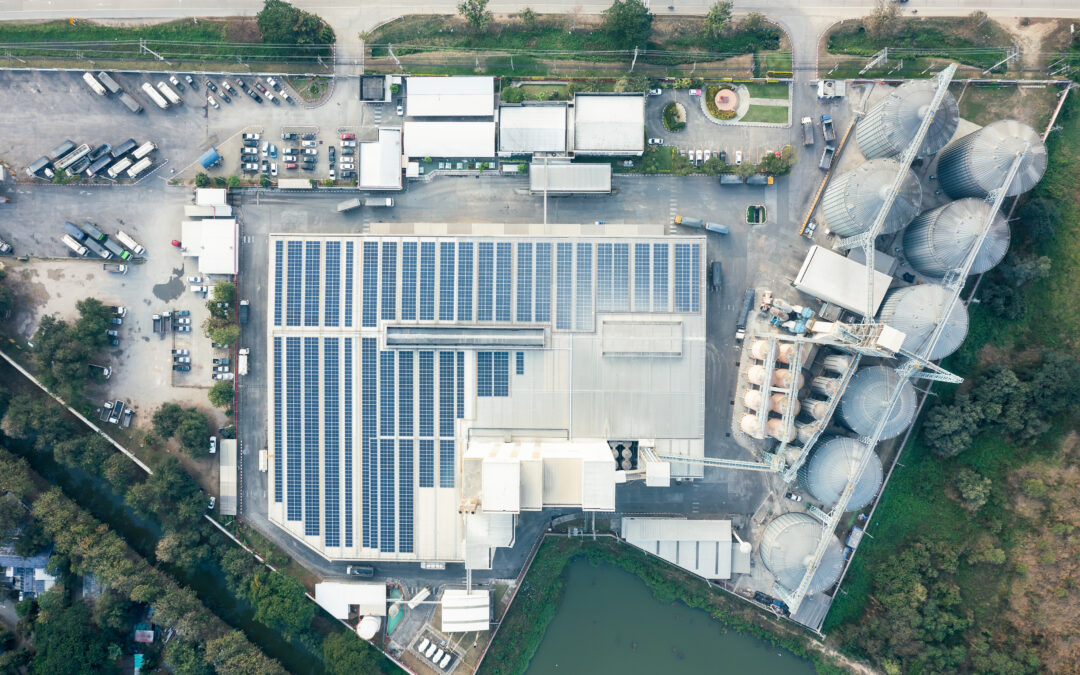There’s a clear call for action for investors to focus on the emissions, energy, and efficiency at commercial properties
A paradigm shift is underway in the rapidly evolving landscape of commercial real estate. The industry once focused solely on managing “concrete boxes,” now finds itself at the intersection of energy and technology. This transformation presents both unprecedented challenges and extraordinary opportunities for asset owners and managers.
For our podcast, Renewable Rides, we recently had the chance to speak with two experts on solar for commercial properties and decarbonization: Fifth Wall CEO and CIO Brendan Wallace and Brendan McCarthy, Head of Real Estate Sustainable Investment at Calvert Research and Management. They talked to us about how solar for commercial buildings and sustainable solutions is a potential profit center for real estate owners and how investing in solar protects owners against future stranded assets.
From Cost Center to Profit Center
Once seen as a cost center, energy is now becoming a potential profit center for real estate owners. Historically, landlords had little control over energy, especially under triple net leases where tenants are responsible for their energy bills. But this dynamic is changing.
As grid reliability decreases and energy costs rise, buildings can no longer be passive electricity consumers. The opportunity lies in turning buildings and the built environment into power plants. By integrating onsite energy solutions—such as solar panels, battery storage, and electric vehicle infrastructure—building owners can significantly reduce their reliance on the grid, lower energy costs, and generate additional revenue.
The potential for this transformation is immense. Less than 3% of commercial buildings have solar panel installations. In 2016, the U.S. National Renewable Energy Laboratory estimated that there are over 8 billion square meters of suitable roofs in the U.S. for solar installations. Together, these installations could produce about 1,400 terawatt hours of electricity each year—nearly 40% of the total electricity currently sold by utilities.
The levelized cost of energy for solar is less expensive than grid-supplied energy, yet adoption by the commercial sector is still slow. The organizations with the most commercial solar installations are retailers because they have an operational intensity that encourages them to use technology or operational advantages. Wallace explains, “The real estate sector has never really had to do that. And as a result, it just takes a long time for the industry to act.” He compares the adoption of solar for commercial buildings to adding digital infrastructure on roofs. “It’s been an imperative for three decades now, and still a lot of real estate owners haven’t evaluated that opportunity. So I think what we’re confronting is a sociological or anthropological problem around how real estate thinks about technology and innovation.”

Increasing Property Values with Onsite Energy
As VECKTA’s CEO, Gareth Evans, recently wrote for his blog, Powering Profits, reducing operating costs through onsite energy solutions can directly increase property owners’ Net Operating Income (NOI) and, consequently, their property value. He gives an example of a VECKTA Self Storage customer adding $6 million in property value by saving $300,000 in energy costs with a commercial solar installation and battery storage.
Depending on state policies, commercial property owners can generate additional income by selling energy to tenants, the grid, or other consumers. They can also earn and sell carbon credits for emissions reductions. The federal Inflation Reduction Act offers significant tax incentives, including a 30-50% solar tax credit for commercial solar systems and battery storage projects. Accelerated depreciation on these projects can lead to substantial tax savings.
Both Wallace and McCarthy agreed that energy-optimized buildings can command premium rents and attract high-quality, credit-worthy tenants. Moreover, properties with onsite energy systems are better protected against climate-related risks and rising insurance costs.
Considering Financial Materiality in Onsite Energy Decision-Making
Despite these benefits, as Wallace explained, property owners are still moving at a glacial pace in adopting energy technologies, sustainable solutions, and building adaptation infrastructure. McCarthy says the main reason is that most firms don’t have the internal resources and lack the expertise to take on a project and properly value the investment. There’s a perception of high upfront costs and unclear ROI plus triple-net leases often create disincentives for energy upgrades.
There are absolutely risks to assess and challenges when considering a commercial solar installation or battery storage, such as determining if the roof is in the right condition to withstand rooftop solar panels or limitations of the lease structure. However, McCarthy says these are all things that can be dealt with, and if you tie this decision to financial materiality and consider the net present value of the associated risks, it makes sense to learn about onsite energy and invest in it now. The downside to waiting until later is an increased risk of having stranded assets down the road that you can’t sell or refinance.
How to Evaluate Solar for Commercial Buildings and Sustainability Solutions
Smaller commercial property owners have an equal advantage in creating an energy-efficient portfolio as large players. While the larger firms may have more capital to invest in solutions like commercial solar installations, they also have the most legacy issues to contend with and the added challenge of scaling them. For both large and small players, the place to start is by looking at the materiality of risks and prioritizing mitigation from there.
Consider the risks associated with climate change, energy costs, outages, emissions, or water scarcity. After you identify the largest material risks and opportunities for each commercial property, and allocate capital towards them, you will have superior growth – whether large or small.
McCarthy gave an example of how to think through this scenario: Consider a typical payback of between 5 and 10 years for a commercial rooftop solar system. Assuming a 10-year payback, that’s a 10% cap rate on self-storage or industrial properties. Industrial properties trade at about a 3% cap rate, so if you are a commercial property manager and want a superior capital allocation, an investment in solar is financially advantageous. Do you want to allocate capital toward acquiring more assets at a 3% return or rolling out solar PV for your portfolio for a 10% return? “We always advocate for pursuing superior capital allocation and in this case, sourcing renewable energy is the winner.”
Corporate Facing Vs. Consumer-Facing: A Lens to Evaluating Solar for Commercial Buildings
In speaking with commercial property owners and assessing solar for commercial buildings, we see a ton of variability in how they’re thinking about and valuing the benefit given the fact that every property will face unique challenges and opportunities. Add on the impact regionality plays and it’s clear that setting an industry standard in evaluating value gain is difficult. However, McCarthy says that one way to simplify how we look at properties when evaluating an onsite energy or decarbonization solution is to think about them as either consumer-facing or corporate-facing.
Examples of consumer-facing properties are self-storage, multifamily, or retail centers. Corporate-facing buildings include offices, warehouses, and industrial facilities. McCarthy explains that property owners need to evaluate what energy, efficiency and adaptation solutions will return the most benefits for each type of building. At this point, many corporations have net zero goals and for most a big part of their emissions comes from real estate. As a result, corporate tenants will pay a premium for greener, less-emitting real estate and if you are a property owner offering those buildings, you can command higher rents but you will also attract higher quality, higher credit tenants and more leasing traffic. This is a bond-like investment.
“So you take these three together, increased rents, higher credit tenants, increased leasing traffic. There’s a clear call for action for your investors to focus on the emissions and the energy and efficiency at your property,” McCarthy said.
Conclusion
In our interview with Brendan Wallace, we asked him when he would consider himself successful. “I will have been successful when the real estate industry truly has internalized that it is both a technology industry and an energy industry at the same time.” His answer illustrates just how much technology will play a role in commercial property ownership and management in the years to come. Thus we harken back to the statement we began this article with – the real estate industry is at the intersection of energy and technology.
For estate owners and investors, the message is clear: embracing these changes is not just about being environmentally responsible—it’s about staying competitive and profitable in a rapidly evolving market. Those who adapt quickly stand to gain significant advantages in terms of cost savings, tenant attraction, and access to capital. The transformation of the real estate industry from passive “concrete boxes” to active power producers is underway, and the opportunities for innovation and growth are immense.



